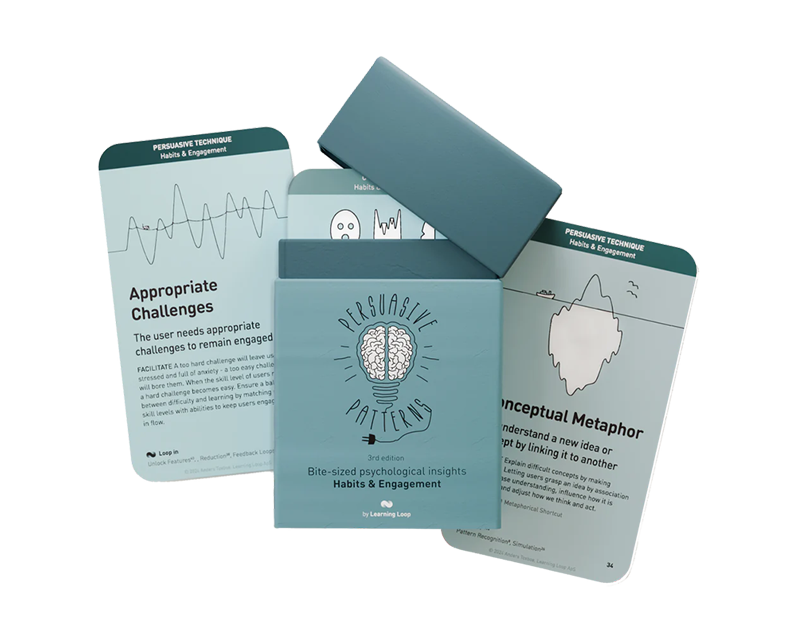Persuasive Patterns: Temptation
Achievements
We are engaged by activities in which meaningful achievements are recognized
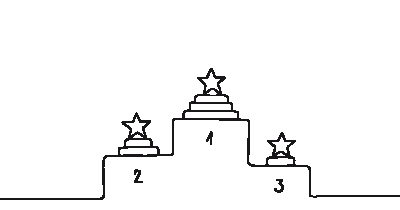
Achievements are used to acknowledge user efforts and successes, motivating continued engagement and fostering a sense of accomplishment. This pattern is particularly effective in environments where users’ progress can be quantified or qualitatively assessed. By celebrating small wins and major milestones, achievements can enhance user loyalty, increase motivation, and encourage the desired behaviors.
The human desire for achievement is a powerful motivator, shaping our actions from a young age. Consider a child’s beaming pride upon completing a challenging puzzle or an adult’s sense of accomplishment after mastering a new recipe. These scenarios highlight our inherent satisfaction in achieving goals and receiving recognition for our efforts]. This fundamental human drive is precisely what the “Achievements” pattern in design taps into.
The allure of achievement extends into the digital world. Similar to the satisfaction gained from mastering a recipe, many digital products capitalize on the Achievements pattern to motivate users. Take, for instance, a popular fitness app that awards badges for reaching daily step goals or completing specific workout routines. These digital badges function similarly to the child’s sense of accomplishment after completing a puzzle. They provide a tangible recognition of effort and progress, motivating users to continue their fitness journey
The study
Deci and Ryan’s (2000) groundbreaking work on Self-Determination Theory posits that intrinsic motivation flourishes when three core needs are fulfilled: competence, autonomy, and relatedness. Achievements directly addresses the competence need by providing users with tangible markers of progress. These markers, in turn, foster a sense of mastery and accomplishment, intrinsically motivating users to continue their endeavors.
Deci and Ryan’s (2000) research provides a powerful illustration of the “competence need” and its connection to intrinsic motivation. Their study divided participants into groups that completed tasks with varying levels of autonomy and feedback (a marker of competence). The results were striking: participants who received informative feedback about their performance (a form of achievement recognition) displayed a significant 90% increase in intrinsic motivation compared to those who received no feedback. This research underscores the power of acknowledging progress in fueling user engagement.
Deci, E. L., & Ryan, R. M. (2000). The “what” and “why” of goal pursuits: Human needs and the self-determination of behavior. Psychological Inquiry, 11(4), 227–268.
The human desire for achievement transcends mere external rewards. We are motivated by accomplishments that hold personal or social significance, representing appropriate challenges that match our gradually rising skill level. As we progress from one achievement to the next, these milestones not only fuel a sense of accomplishment but also serve as valuable data points. Achievements help users anchor their expectations about what goals are attainable. They provide social proof by showcasing what others have accomplished, motivating users to believe similar feats are within their grasp. This social comparison fosters a sense of self-efficacy, the belief in our ability to succeed.
When faced with choices, we often rely heavily on the first piece of information presented, a phenomenon known as the Anchoring Effect. In the context of achievements, well-designed milestones act as anchors, guiding users towards realistic and attainable goals. Setting goals that are too low can lead to boredom and a sense of wasted potential, while overly ambitious targets can be paralyzing. Achievements bridge this gap by establishing a clear roadmap for progress, ensuring users remain motivated and challenged throughout their journey.
Witnessing others achieve success through trophies and badges serves a powerful purpose. It communicates the idea that these goals are obtainable, not just for a select few, but for users with similar skill sets. This fuels our belief in our own self-efficacy, the conviction that we can achieve something with dedicated effort. Of course, the key lies in ensuring the presented goals are relevant to the user’s current skill level and align with their overall learning curve.
Completing a goal is inherently rewarding. The sense of accomplishment serves as a potent motivator, propelling users forward in their endeavors. This is particularly true when users are nearing completion of a milestone. Imagine a fitness app that awards badges for reaching daily step goals. As users approach a weekly goal, the anticipation of achievement can significantly boost their motivation to maintain their exercise routine.
Clearly defined goals, broken down into smaller, achievable tasks, significantly increase the likelihood of completion. This commitment clarity enhances the user’s resolve and propels them towards their desired outcome. Furthermore, encouraging users to publicly commit to their goals can further solidify their resolve. The act of public declaration strengthens the user’s commitment and fosters a sense of accountability.
A readily accessible list of potential achievements provides valuable feedback on a user’s progress. It not only showcases how much has been accomplished but also offers a clear view of what remains to be achieved. This transparency serves a dual purpose: it motivates users to close the gap and complete outstanding tasks, while simultaneously offering valuable insights into potential future endeavors within the product or service.
Social Proof is our tendency to rely on the actions of others when navigating unfamiliar situations. Achievements tap into this principle by showcasing the accomplishments of other users. Badges and trophies become a form of social currency, demonstrating not only individual credibility but also highlighting which achievements are considered valuable within the user community. This visibility motivates users to strive for similar accomplishments.
Humans are naturally inclined to seek objective information about our performance. In the absence of such data, we resort to comparing ourselves to others we perceive as similar. Achievements, trophies, and badges earned by other users provide a convenient benchmark for this social comparison. Seeing peers achieve a specific goal can ignite a sense of healthy competition and motivate users to pursue similar accomplishments.
Designing products with Achievements
Don’t settle for rewarding trivial actions. Craft achievements that recognize meaningful progress along a user’s journey within your product. Consider your product’s core functionalities and goals, and design achievements that acknowledge users for mastering key skills or completing significant milestones. For instance, a language learning app might award badges for completing vocabulary lessons or achieving fluency in a specific conversation topic.
Offer a variety of achievements to cater to different user preferences and engagement styles. Some users might be motivated by conquering complex challenges, while others thrive on the satisfaction of ticking off smaller tasks. A balanced mix of achievement types, from short-term badges to long-term goals, keeps users engaged over time.
Don’t just tell users they’ve achieved something, show them! Visually appealing badges, trophies, or icons associated with achievements provide a sense of accomplishment and serve as constant reminders of progress. These visual cues can be displayed on user profiles, dashboards, or within the user interface itself, fostering a sense of pride and accomplishment.
Make the goal clear and attainable
Clearly articulate what is possible with your product. What challenges and desired behaviors do you want to encourage? Achievements can help anchor user ambitions and guide them towards your desired outcomes. Showcase achievements earned by similar users to provide social proof. This visibility motivates users to strive for similar accomplishments.
Long-term goals can feel overwhelming. Break them down into smaller, achievable milestones. This allows users to experience a sense of accomplishment more frequently, keeping them motivated on their journey. Imagine a fitness app that awards badges for reaching daily step goals, as well as more prestigious trophies for achieving significant weight loss milestones. This incremental recognition system fosters a sense of progress and motivates users to keep striving towards their ultimate goals.
Integrate achievements with the progression of your user journey
Tie achievements to the unveiling of new features or exclusive content within your product. This incentivizes users to pursue achievements, not just for the recognition itself, but also for the privilege of accessing new functionalities or experiences. For example, a photo editing app might unlock advanced filters or editing tools upon completion of specific achievement-based challenges.
While intrinsic motivation is powerful, coupling achievements with extrinsic rewards can further enhance their impact. Rewards might include access to new features, discounts, or digital goods that enhance the user’s experience. Ensure that these rewards are desirable and add real value to the user’s interaction with the product.
To keep users engaged and informed about their progress towards achievements, integrate continuous feedback mechanisms into your design. Use notifications, progress bars, or pop-up messages to let users know how close they are to earning an achievement, what they need to do to get there, and congratulate them upon success. A publicly accessible list of potential achievements allows users to track their progress and see how much remains to be accomplished. Furthermore, achievements can communicate what’s possible and what directions a user can take within the product.
As users evolve in their journey, the achievements should also grow in complexity and prestige. This creates a scalable challenge that keeps advanced users engaged long after they have mastered the basics. In a gaming context, initial achievements might be tied to simple tasks, but later achievements should require greater skill or dedication to unlock.
Provide appropriate challenges. Break down a larger goal into smaller, more easily obtainable wins that match the gradually rising skill level of your users. A challenge that’s too difficult can leave users stressed and defeated, while something too easy can lead to boredom.
Keeping the right balance
Relying too heavily on extrinsic rewards can diminish intrinsic motivation over time. While extrinsic rewards can be beneficial, rely primarily on intrinsic motivators. Overemphasizing external rewards can diminish the inherent satisfaction of achievement. Ensure achievements also recognize personal growth and learning, not just the completion of tasks.
Awards that do not align with user goals or the core experience can feel meaningless. Ensure each achievement adds value to the user’s journey and relates closely to their objectives within the platform.
Sporadically giving out achievements or having unbalanced difficulty levels can lead to user frustration. Don’t flood users with badges for completing insignificant tasks. Focus on achievements that recognize meaningful progress towards a larger goal. Maintain a consistent and predictable system for how and when achievements are awarded.
Ensure achievement criteria are clear and easy to understand. Users should know exactly what they need to do to earn an achievement. Offer a balanced mix of achievement types. Don’t overwhelm users with only long-term goals, or conversely, only trivial tasks.
Provide clear and consistent feedback on progress towards achievements. Keep users informed of their standing and motivate them to keep striving. If achievements are not easily visible or acknowledged within the community, they lose their effectiveness. Ensure that achievements are prominently displayed and recognized within the user interface.
Ensure that achievements do not become the sole focus, which might lead users to engage in activities solely for rewards rather than genuine interest or enjoyment.
Ethical recommendations
An overly rewarding system for trivial actions, or setting excessively high requirements for achievements, can foster obsessive behavior. This is why it is vital to strike a balance that motivates users without fostering unhealthy fixations on achievements.
Inequity is another significant risk; a system that predominantly focuses on achievements may alienate users who are intrinsically motivated by aspects such as learning or exploration. This can lead to demotivation and disengagement, particularly if achievements are perceived as the only value metric. Moreover, if achievements are emphasized too heavily, they might overshadow the intrinsic satisfaction derived from the activities themselves, reducing the overall experience to a hunt for extrinsic rewards like badges or points.
Social elements such as leaderboards or public displays of achievements can also lead to negative experiences for some users by fostering unhealthy social comparisons or feelings of inadequacy. It is crucial to consider how these features might impact user psychology and offer options to keep achievements private, catering to users who prefer a more personal experience.
Furthermore, achievements can be manipulated unethically to drive user behavior in undesirable directions. This includes gamifying actions with potentially negative consequences or exploiting users’ vulnerabilities, which can undermine trust and long-term engagement.
To ensure that the achievements pattern is used ethically and remains user-centric, consider the following best practices:
- Provide meaningful achievements
To use the achievements pattern responsibly and ethically, focus on creating meaningful achievements that genuinely reward progress and skill development rather than trivial actions. This will help foster a sense of true accomplishment and also validates user effort in a meaningful way. - Be transparent
Clearly communicate how achievements can be earned and what they represent. Avoid obscure mechanisms that could confuse or mislead users. Additionally, allowing users to control the visibility of their achievements can help cater to individual preferences and comfort levels. - Variety and balance
Offer a diverse range of achievements to cater to different user motivations and preferences, balancing intrinsic and extrinsic motivators. This variety ensures that the system appeals to users with different goals and engagement styles, making the experience more inclusive. - Facilitate a natural journey
Focus on enhancing the user journey with achievements rather than defining it through them. Celebrate user progress and encourage continuous exploration and learning, ensuring that achievements supplement rather than dominate the experience. - Gamify, ethically
Prioritize user well-being and avoid tactics that manipulate or exploit. By fostering an environment that values fair play and genuine accomplishment, you can leverage achievements to enhance user experience responsibly.
Real life Achievements examples
Starbucks
Starbucks Rewards uses a tiered achievement system where customers earn stars for purchases. These stars lead to higher status and perks, motivating continued patronage and enhancing customer loyalty.
Codecademy
In online learning, Codecademy awards users with badges for completing programming courses and projects, motivating learners to continue advancing their skills
Strava
The fitness app awards badges for reaching daily step goals, completing workouts, or participating in fitness challenges. These achievements provide a sense of accomplishment and motivate users to stay active.
Trigger Questions
- What core user behaviors do we want to encourage?
- How can we align these achievements with our users' goals and values?
- Are the achievements we've designed both challenging and attainable?
- What are the natural milestones users encounter?
- Do our achievements offer a clear sense of progress?
- Is the difficulty level of achievements appropriate for our user base?
- How can we leverage social proof to enhance achievements?
Pairings
Achievements + Social Proof
By displaying achievements publicly, such as on social media or within community leaderboards, you leverage social proof to enhance the value of the achievements. This not only motivates the achiever but also inspires others to engage in similar behaviors.

We are engaged by activities in which meaningful achievements are recognized

We assume the actions of others in new or unfamiliar situations
Achievements + Goal-Gradient Effect
Pairing achievements with the goal-gradient effect, where users’ efforts increase as they approach a goal, can be powerful. As users progress and unlock achievements, their perceived value and effort towards reaching subsequent levels or achievements increase, driving continuous engagement.

We are engaged by activities in which meaningful achievements are recognized

Our motivation increases as we move closer to a goal
Achievements + Feedback Loops
Integrating achievements with feedback loops provides users with real-time, actionable feedback as they progress towards a goal. This can increase the psychological impact of achieving milestones, making the journey towards each achievement more engaging.

We are engaged by activities in which meaningful achievements are recognized
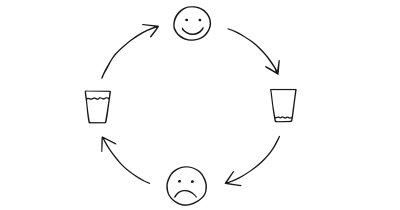
We are influenced by information that provides clarity on our actions
Achievements + Endowed Progress Effect
This effect involves providing users with a head start in an achievement system, which can motivate continued effort towards completion. For example, starting users off with a small percentage already completed towards their first achievement can spur continued user activity and engagement.

We are engaged by activities in which meaningful achievements are recognized

Early help speeds up goal achievement
Achievements + Temptation Bundling
This pairing links desired behaviors (like completing tasks or learning modules) with pleasurable experiences (like accessing exclusive content or rewards). By bundling tasks that contribute towards achievements with intrinsic rewards, users are more likely to engage consistently. This method not only promotes habitual use of a product but also enhances the perceived value of achieving milestones.

We are engaged by activities in which meaningful achievements are recognized
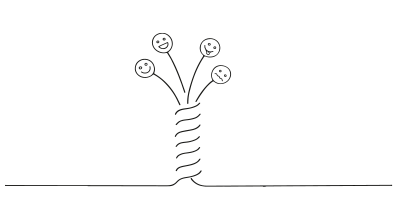
Engaging in hard tasks is more likely when coupled with something tempting
Achievements + Curiosity Effect
Utilizing the curiosity effect, where users are motivated to find out what will happen next, can be synergized with achievements to keep users engaged. For instance, teasing upcoming rewards or new features that unlock after reaching certain achievements can keep users interested and motivated to discover what’s next.

We are engaged by activities in which meaningful achievements are recognized

We crave more when teased with a small bit of interesting information
Achievements + Recognition over Recall
This combination uses the ease of recognizing achievements (through visual badges or icons) rather than requiring users to recall their accomplishments. This can enhance the user experience by making progress and achievements easy to track and visually satisfying, thereby reinforcing engagement and satisfaction.

We are engaged by activities in which meaningful achievements are recognized
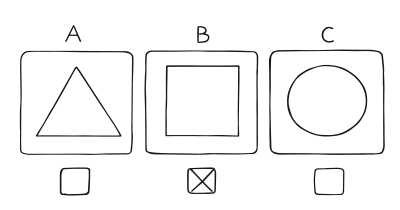
We are better at recognizing things than we are recalling them from memory
Achievements + Sequencing
Breaking down long-term goals into smaller, more manageable achievements (Sequencing) can help maintain user engagement by providing frequent moments of accomplishment. This method helps keep the tasks from becoming overwhelming and keeps users feeling motivated by their steady progress.

We are engaged by activities in which meaningful achievements are recognized

Break down complex tasks into small and easily completed actions
A brainstorming tool packed with tactics from psychology that will help you build lasting habits, facilitate behavioral commitment, build lasting habits, and understand the human mind. It is presented in a manner easily referenced and used as a brainstorming tool.
Get your deck!- Perceived self-efficacy in cognitive development and functioning by Bandura
- A Theory of Social Comparison Processes by Festinger
- Johnson, D., & Smith, J. (2015). Engagement and reward: The role of achievements in successful game design. Journal of Gaming and Virtual Worlds, 7(2), 123-136.
- Deci, E. L., & Ryan, R. M. (2000). The "what" and "why" of goal pursuits: Human needs and the self-determination of behavior. Psychological Inquiry, 11(4), 227–268.
- Dweck, C. S. (2006). Mindset: The new psychology of success. Random House.
- Pedreira Migues, V., Silva Azevedo, A., & Pain, H. (2015). Gamification in fitness apps: A review of the literature. Entertainment Computing, 6(C), 1–11.
- Kapp, K. M. (2014). Gamification in education and training: An instructional design guide. IGI Global.
- Locke, E. A., & Latham, G. P. (2002). Building self-efficacy: The importance of goal setting. Applied Psychology: An International Review, 51(1), 117–130.
- Skinner, B. F. (1954). The science of learning and the art of teaching. Harvard Educational Review, 24(2), 86-97.
- Ling, K., Beenen, G., Ludford, P., Wang, X., Chang, K., Li, X., et al. (2005). Using social psychology to motivate contributions to online communities. Journal of Computer-Mediated Communication, 10(4).
- Bandura, A. (1993). Perceived self-efficacy in cognitive development and functioning. Educational Psychologist, 28(2), 117–148.
- Festinger, L. (1954). A Theory of Social Comparison Processes. Human Relations, 7(2), 117–140.
- Csikszentmihalyi, M. (1990), Flow: The Psychology of Optimal Experience, Journal of Leisure Research, 24(1), pp. 93–94.
- Self-Determination Theory by Anders Toxboe
